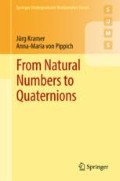Abstract
This chapter deals with the search for fields that extend the field of complex numbers to an even more encompassing field. Since we can view the set of complex numbers as a two-dimensional real vector space, it makes sense to begin by looking for a field that arises from a three-dimensional real vector space. It turns out, however, that no such field exists. In contrast, we discover that a field arising from a four-dimensional real vector space exists, provided that we abandon commutativity of multiplication. In this way, we are led to the construction of the skew field of Hamilton’s quaternions. In the appendix to the last chapter, we ask whether there can exist a number system that even extends Hamilton’s quaternions. It turns out that also giving up associativity of multiplication, there is precisely one additional extension, Cayley’s octonions, which brings to a close our investigation of number systems.
Access this chapter
Tax calculation will be finalised at checkout
Purchases are for personal use only
Preview
Unable to display preview. Download preview PDF.
References
[1] J. C. Baez: The octonions. Bull. Amer. Math. Soc. (N.S.) 39 (2002), 145–205.
[2] J. C. Baez: Errata for: “The octonions” [Bull. Amer. Math. Soc. (N.S.) 39 (2002), 145–205]. Bull. Amer. Math. Soc. (N.S.) 42 (2005), 213.
[3] J. H. Conway and D. A. Smith: On quaternions and octonions: their geometry, arithmetic, and symmetry. A K Peters, Natick, MA, 2003.
[4] H. Ebbinghaus et al.: Numbers. Translated from the 2nd German 1988 edition by H. L. S. Orde. Springer, Berlin Heidelberg New York, 1991.
[5] H. Hopf: Ein topologischer Beitrag zur reellen Algebra. Comm. Math. Helvetici 13 (1940/41), 427–440.
[6] A. Hurwitz: Über die Komposition der quadratischen Formen. Math. Ann. 88 (1922), 1–25.
[7] J. Milnor: Some consequences of a theorem of Bott. Ann. of Math. (2) 68 (1958), 444–449.
[8] B. L. van der Waerden: A history of algebra. From al-Khwarizmi to Emmy Noether. Springer, Berlin Heidelberg New York, 1985.
Author information
Authors and Affiliations
Corresponding author
Rights and permissions
Copyright information
© 2017 Springer International Publishing AG
About this chapter
Cite this chapter
Kramer, J., von Pippich, AM. (2017). Hamilton’s Quaternions. In: From Natural Numbers to Quaternions. Springer Undergraduate Mathematics Series. Springer, Cham. https://doi.org/10.1007/978-3-319-69429-0_6
Download citation
DOI: https://doi.org/10.1007/978-3-319-69429-0_6
Published:
Publisher Name: Springer, Cham
Print ISBN: 978-3-319-69427-6
Online ISBN: 978-3-319-69429-0
eBook Packages: Mathematics and StatisticsMathematics and Statistics (R0)

